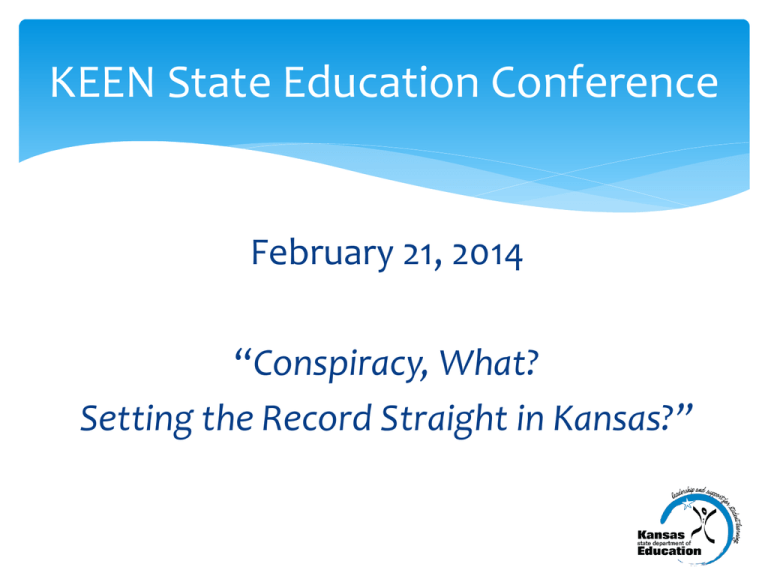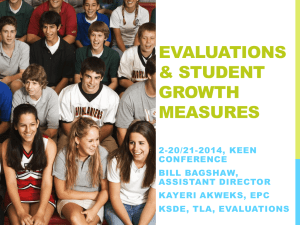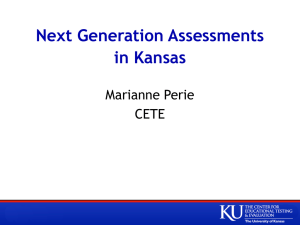Conspiracy, What? Setting the Record Straight in Kansas?
advertisement

KEEN State Education Conference February 21, 2014 “Conspiracy, What? Setting the Record Straight in Kansas?” College and Career Ready means an individual has the academic preparation, cognitive preparation, technical skills, and employability skills to be successful in postsecondary education, in the attainment of an industry recognized certification or in the workforce, without the need for remediation. Level of performance on college readiness exams for full admittance to postsecondary institutions without the need for remediation Achievement of an industry recognized certification that enables students to advance in a career pathway Problem formulation, research, interpretation, communication, precision and accuracy Reading Writing Listening Speaking Math Decisive Creative Thinking Solves Problems Reasons Social Awareness Responsible Decision Making Self-Management and SelfAwareness Ability to engage in exploration and planning relevant to the students interests, for career preferences leading to postsecondary success Kansas ESEA Flexibility Waiver Overview 13 Why Was ESEA Waiver Available? Congress hasn’t reauthorized Elementary & Secondary Education Act (ESEA), currently known as No Child Left Behind (NCLB) Should have been done in 2007 U.S. Department of Education (ED) offered states opportunity for relief from certain provisions of ESEA In order to improve academic achievement and increase the quality of instruction for all students through state and local reforms 14 Why Kansas Sought a Waiver? To move away from the narrowly defined accountability system in NCLB To have a new accountability system that uses multiple measures with goals that are unique to each school/district To have results which are more meaningful measures of the success and progress of Kansas schools KS is already doing many of the parts, i.e. common core standards 15 What KS Agreed to- Principles 1. College- and Career-Ready Expectations for All Students • • Kansas College and Career Ready Standards New assessments with a CCR benchmark 2. State-Developed Differentiated Recognition, Accountability, and Support • Multiple views of student performance (4 AMO’s) 3. Supporting Effective Instruction and Leadership • All school districts now have an approved teacher/leader evaluation instrument 16 Waiver Components 1. Extend our current ESEA Waiver another year. 2. Respond to our current conditional “high risk” status. 3. Amend items in our Current Waiver. 4. Move the use of using student growth to inform personnel decisions until 2017-18 State Assessments Scott Smith, Director Career, Standards and Assessment Services But how much is changing, really? Transition assessment in Spring 2014 is the same as we have always planned Spring of 2015, when we would have had SBAC for the first time, we will have an enhanced Kansas assessment. By Spring of 2016, we will be very close to where we would have been with SBAC with difference due to choices made in Kansas. Spring 2014 Transition Assessment Delivered on KITE Aligned with Kansas College and Career Ready Standards for math, reading, and writing conventions Follows similar blueprint to SBAC, including technologyenhanced items Machine-scorable items only No performance task No writing prompt No listening items New Development in 2014–2015 The transitional test will serve as the backbone for the new Kansas College and Career Ready Assessment Enhancements Listening section Writing prompt Math performance tasks Spring 2015 The core machine-scorable part of the test will be parallel to what was administered in 2014, but we will refresh the item pool. We will field test the enhancements. Accountability for 2015 will be based on the core portion of the test. Schools and districts will receive feedback on the fieldtest portions to help gauge student readiness on the full set of standards. Summer 2015 After analyzing the field-test items, we will create the best form possible that includes all features of our future assessment. We will set new achievement standards (cut scores and performance level descriptors) based on that form. Using those new cut scores, KSDE will set new AMOs and communicate the new targets to schools and districts. Spring 2016 Now we have a fully enhanced test that covers all of the Kansas College and Career Ready Standards. We should also have sufficient numbers of items to make the test adaptive this year as well. Adaptivity The test will be adaptive to allow students to be measured on items close to their ability level. We are considering stage adaptivity rather than item adaptivity that SBAC uses. Benefits More reliable estimates Targets assessment to student level Requires fewer items than item-level Summary Spring 2014 Core machine-scorable items aligned with KCCRS Core machine-scorable items Spring 2015 aligned with KCCRS Math Performance Task Core machine-scorable items Spring 2016 aligned with KCCRS Adaptivity Essay Listening Items Complete enhancements (performance task, essay, listening items) Special Education Adaptivity should help students who used to take the KAMM. They will be assessed on grade-level, but with easy items. Many tools are available to all students (e.g., highlighter, notes, calculator) Accommodations are available electronically (contrast, auto font) TTS is available in a new and improved voice this year. Kansas Fingerprints We want Kansas educator and stakeholder fingerprints all over these new assessments Design decisions Item writing Item reviewing Range finding Scoring Standard setting Kansas Stakeholders Administrators Support teacher involvement Voice in report decisions Cross-content development Kansas Board of Regents High school — we want to ensure that tests truly predict college readiness Will be involved in design and review of assessments and setting cut scores Full Kansas Assessment Program Summative assessment ELA (complete in 2016) Math (complete in 2016) History/government (complete in 2016) Science (complete in 2017) Formative tools Really more like sample items now Developing capacity for teachers to build test forms using item pool In 2016, we can start building true formative, instructionally-embedded tests. Will include science and H/G Individual Plans of Study (IPS) KEEN Topeka February 21, 2014 What is an IPS? Multi-year educational plan based on career interests The Kansas State Department of Education strongly recommends that all districts implement individual plans of study (IPS) for all students in grades 8 through 12. 8th grade – career interest survey, develop individual plan of study (at a minimum, include career interests and all courses 9 – 12 + 1 year of post-secondary plans) Here’s what we’re facing… Kansans with “Some Post-secondary” 52% ome Post-secondary = Credential through Advanced degree Kansas Class of 2011 % Graduates enrolling in Post-secondary education (2 and 4 year institutions) 76% % Graduates enrolling in Post-secondary education earning 1 year of college credit 49% *System for Education Enterprise in Kansas (SEEK) Why an IPS? Student’s Educational Path becomes: Relevant → Higher Student Engagement Focused → based on Career Interests Efficient → time and $ Not a silver bullet, but an IPS will help a student make better choices and ultimately lead to a higher % of post-secondary completion Student – Individual Plans of Study (IPS) webpage Individual Plans of Study Evaluations & Student Growth Measures Bill Bagshaw, Assistant Director Kayeri Akweks, Education Program Consultant, Teacher Licensure and Accreditation/Evaluations Federal WAIVER - Principle 3 Supporting Effective Instruction and Leadership Implement teacher and principal evaluation and support systems that: 1. Are used for continual improvement of instruction 2. Use at least 3 performance levels 3. Use multiple measures including student growth as significant factor 4. Are used to evaluate on a regular basis 5. Provide clear, timely, and useful feedback 6. Are used to inform personnel decisions Evaluation Systems for 2013-2014 and 2014-2015 As of June 3, 2013 – 278 districts have submitted their Assurances Form 267 districts have had their Assurances Form approved 93 districts will be using the KEEP Repository 146 districts will be using vendors 46 districts will be using locally created evaluation systems As of Feb 17, 2014 – Districts are completing their D2 Assurances Form online for 20142015 All Districts must use an evaluation final summative rating for each individual educator evaluation All Districts must include student growth measures in their evaluations Things to Know Student Growth Measures: Kansas school districts will include student growth as a significant factor in the evaluation of classroom teachers and building leaders. State approved student growth measures will document the specific amount of student growth attributable to the teacher or building leader between two identified points in time. Multiple measures of student growth (more than one) must be met before an educator can be rated as effective or highly effective. State assessments are one possible measure and are a required measure for all grade levels and content areas that give them. Commercially purchased assessments and locally developed performance assessments may also be used, once they are approved by the KSDE. KSDE Guidance for school districts: LEAs should use the commercially purchased and locally developed student growth measures they currently have. State assessments are required as given. All grade levels across schools in a district should use the same measures. Local performance assessments should be collaboratively designed, reviewed and used across the district with strict adherence to an inter-rater agreement. Student Growth Objectives (SGOs) or Student Learning Objectives (SLOs) are to be developed with collaborative districtwide teams. Next steps: All districts will identify student growth measures to be used and provide them to the KSDE (in a format to be determined) by June 30, 2014. A “default list” of student growth measures for LEA reference will be available and posted on the web by May 1, 2014. 2014-2015 All Evaluations KANSAS Final Summative Evaluation Rating Chosen Instructional Practice Protocol SUMMARY RATING #1 FINAL Summative Evaluation Rating Three Student Growth Measures SUMMARY RATING #2 Matrix Works with or Without Percentages Matrix Used to Determine Summative Evaluation Rating 1-24-2014.jpg DRAFT Default List of SGMs DRAFT Default List of Student Growth Measures 1-27-2014.pdf The Draft Default List of SGMS is in progress and will be available by June 1, 2014. Optional Template Questions Bill Bagshaw, Assistant Director KSDE – TLA bbagshaw@ksde.org 785-296-2198 Kayeri Akweks, EPC KSDE – TLA kakweks@ksde.org 785-296-5140 RIGOR RESULTS RESPONSIVE CULTURE RELEVANCE RELATIONSHIPS What is different about the new Kansas Accreditation Model? College and Career Ready At the Forefront of Accreditation Work Kansas College & Career Ready definition: College and Career Ready means an individual has the academic preparation, cognitive preparation, technical skills, and employability skills to be successful in postsecondary education, in the attainment of an industry recognized certification or in the workforce, without the need for remediation. Focus Profiles of 21st Century Learner and Learning RIGOR RESULTS RESPONSIVE CULTURE RELEVANCE RELATIONSHIPS Focus The 5 Rs Differences District Accreditation • The new model focuses on districts rather than individual schools. • All stakeholders are involved in supporting all schools within the system. • All participants are responsible for successes and areas for improvement. Differences Support Rather than Penalize All of the R’s are weighted equally. Relevance, Relationships, Responsive Culture, and Rigor are just as important as Results. Accreditation is no long just about achievement. 2:30-2:45 p.m. Differences Length of Time The accreditation timeline will be over a span of four years. The first cycle will include an interim year to allow districts to prepare for change. Differences Change Goals Districts will utilize the rubrics as a needs assessment over a year-long process. An outside review assists the district in examining areas for change. Two change goals are identified. Strategies are put into place. Data is collected and analyzed. Results are shared with all stakeholders. Differences Potential for Research Reflection is built into the final data analysis. Districts and KSDE will be able to conduct meaningful research based on the changes occurring in districts. We can see how change impacts graduation rates, attendance, drop-out rates, achievement, rural vs urban districts, etc. Accreditation Work completed over the past year • • • • Field Testing Rubrics Definitions Online Evidence Repository • Handbook Accreditation Work To Be Completed on Accreditation Model • • • • Update the web page Revision of QPA Regulations Pilot online repository Develop protocol for change goals and assembling accreditation teams Accreditation Work To Be Completed that Impacts Accreditation • Decisions about AMOs are not finalized • ESEA Waiver is still under review • Student academic growth data is under development • Defining “significant” for educator evaluation is still under review Accreditation New Item - QPA Advisory Council Recommendations Continue the use of Annual Measurable Objectives (AMOs) in place of AYP In 2014-15, all schools are Accredited. Reasons for QPA Recommendations 2014 Math & ELA assessments are pilots First time teachers and students have assessed using the new KITE system First time exposed to new test item types (technology enhanced items) There will not be any cut scores until fall of 2014 Some test items will be “thrown out” after pilot is complete X 1 2 3 4 5 6 7 8 9 10 X X 1 2 3 4 5 6 7 8 9 10 X X X X X X X X X X X 1 2 3 4 5 6 X X 7 8 9 10 X X X X X X X X X X X X X X X X X X X X X X X X X X X 1 2 3 4 5 6 7 8 9 10







